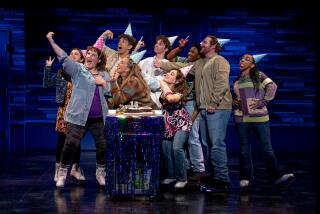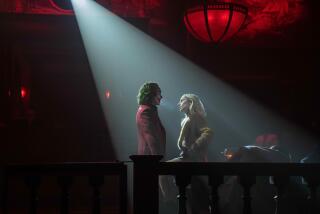Everything old is skewed again in fun ‘Chaperone’
At a time when almost every old musical worth seeing has been revived to death, one solution is to mount a revival of a show that doesn’t exist.
The new mocu-musical, “The Drowsy Chaperone,” which opened at the Ahmanson Theatre on Friday, is a guide to the greatest 1920s song and dance show that never was. “Chaperone” is to the zany musicals of the Jazz Age what “This is Spinal Tap” was to heavy metal: proof that mockery, even more than imitation, is the sincerest form of flattery.
This musical, which previously enjoyed a successful run in Toronto, opens with the line “I hate theater” -- but don’t be fooled. “The Drowsy Chaperone” is an unabashed love letter not just to musical comedy but to those romantic souls for whom show tunes are a daily form of worship.
The entirety of the show takes place in the rundown apartment of a character listed in the program as “Man in Chair.” Played by Bob Martin (who co-wrote the book), this “Man” is the type of person you hope not to get stuck sitting next to on airplanes or in theaters. Opinionated, incapable of making a long story short and prone to divulge far too much information about his personal life, Martin’s “Man” is the audience’s chaperone, baby-sitting us for nearly two hours and using that time to share his favorite LP, a two-record set of a 1928 musical called “The Drowsy Chaperone.”
Martin drops the needle, but the crackle and hiss of vinyl is soon replaced by a 15-piece orchestra, and the musical numbers, at first only described, start to play out on stage by a full cast of singers. Martin provides a sort of running, DVD-style commentary on the action -- more than once stopping the record (and the show) to replay a favorite moment, relate bits of trivia about the musical’s “creators,” Gable and Stein, or analyze his own romantic history in relation to “The Drowsy Chaperone” and musical theater in general.
This type of framing device shouldn’t work. It’s intrusive, unsubtle and, for the most part, serves as a way of putting ironic “air quotes” around the proceedings so as to shield anything stale from criticism (it’s supposed to be bad, get it?). Despite this, the gimmick somehow plays pretty well.
Part of this is due to Martin and co-writer Don McKellar’s knowing book -- despite its reliance on groan-inducing puns and gags (some of the “so bad they’re good” variety, others of the “so bad they’re bad” vintage) -- but mostly it’s due to Martin’s silly but sincere performance.
Dressed in shabby cords and a dorky button-up house sweater, Martin is the very model of the type who makes dates with himself to listen to old records. Martin’s overeager manner of speech, his wide eyes and awkward gestures all give his performance a spontaneity that prevents this breaking-the-fourthwall device from sliding toward self-important smugness.
OK, so the conceit of “The Drowsy Chaperone” works -- but how about the music? Is the fictional score of “The Drowsy Chaperone,” with its showgirls, gangsters and Latin lover, worth dusting off and giving a listen?
“Alcohol enhances nostalgia,” Martin tells the audience as he pours himself a brandy and settles into his chair. Perhaps, but like the Prohibition era in which songwriters Lisa Lambert and Greg Morrison’s “Chaperone” is set, the Ahmanson is a dry house (there’s no intermission). Maybe with the aid of a sidecar, an old- fashioned or a stiff martini, the songs from “The Drowsy Chaperone” might manage to make a few musical lovers giddy, but without that lubricant, Lambert and Morrison’s songs don’t have the intoxicating power of the Porter, Kern and Gershwin standards that inspired them.
The one exception is “Show Off,” which gave everyone in the theater a bona-fide Broadway buzz. It may not actually be a great song (that will be for future “men in chairs” to decide), but as performed by Sutton Foster on opening night, the number was as bright and bubbly as anything running on the Great White Way.
Foster was a winning presence in the 2002 bauble “Thoroughly Modern Millie” (which won her a Tony), but this number is a career-defining moment. “The Drowsy Chaperone” hopes to move on to Broadway -- and if it does, one can safely bet that Foster and “Show Off” will be a centerpiece number at the Tony Awards ceremony next June.
Besides her full-bodied voice and gleaming stage presence, Foster upped the ante by performing this number (complete with splits and cartwheels) with her right arm in a cast. The singer broke her wrist in rehearsal, but a mix of show-must-go-on chutzpah and careful restaging turned this potential pitfall into a piece de resistance.
After “Show Off” and its inevitable encore, one is tempted to think “The Drowsy Chaperone” could become to Foster what “Hello Dolly” was to Carol Channing or “Annie Get Your Gun” to Ethel Merman. But alas, this thoroughly postmodern musical is not that type of show. “Chaperone” is really an ensemble piece, and while it has its pleasures, one can’t help but crave another Sutton Foster showstopper.
Luckily, the Center Theatre Group has cast the ensemble parts with first-rate musical theater talent, which brings out the best in each of “The Drowsy Chaperone’s” other, more modest, numbers. Edward Hibbert and Georgia Engel bring corny conviction to their scenes, and Beth Leavel tries her best to steal the show as the titular Chaperone. With dark eyes that seem snatched from the cover of a Harding-era cover of “Vanity Fair,” Leavel looks the part and knows it. Watch for the way she relishes the made-up word “plumble.” Not since Charles Nelson Reilly appeared in “Strike Up the Band” a few seasons past has an L.A. stage been witness to hamming of this magnitude.
Director and choreographer Casey Nicholaw (of Broadway’s “Spamalot”) gives all the performers a long leash when it comes to chewing scenery and winking at the audience, but he rarely allows them to descend into camp.
Nicholaw shows a similar tact in regard to the design and movement of the show, which is big when appropriate and intimate when necessary.
A perfect example is the finale. The curtain drops as the music and spectacle reach their peak, but at the same time, Martin’s character can be seen sitting down in his fraying chair with yet another snifter of brandy, contentedly gazing at his cherished LP.
Martin, Nicolaw and the creative team may not have made a musical that approaches the genius of the shows it pays homage to, but like the record held delicately in Martin’s fingers, this is a piece of work that has been handled with care.
This consideration, even more than Foster’s star turn, may lift the show above its flaws and allow repeat listening, where real-life men and women in chairs can live vicariously through the cliched but cheerful sounds of “The Drowsy Chaperone.”
*
‘The Drowsy Chaperone’
Where: Ahmanson Theatre, 135 N. Grand Ave., Los Angeles
When: 8 p.m. Tuesdays through Saturdays, 2 p.m. Saturdays and Sundays, 7:30 p.m. Sundays. Dark on Thanksgiving; call for exceptions and additional performances.
Ends: Dec. 24
Price: $20-$90
Contact: (213) 628-2772
Running Time: 1 hour, 45 minutes
Bob Martin...Man in Chair
Georgia Engel...Mrs. Tottendale
Edward Hibbert...Underling
Troy Britton Johnson...Robert
Eddie Korbich...George
Lenny Wolpe...Feldzieg
Jennifer Smith...Kitty
Jason Kravits...Gangster #1
Garth Kravits...Gangster #2
Danny Burstein...Aldolpho
Sutton Foster...Jane
Beth Leavel...Drowsy
Kecia Lewis-Evans...Trix
Book by Bob Martin and Don McKellar. Music and lyrics by Lisa Lambert and Greg Morrison. Directed and choreographed by Casey Nicholaw. Scenic design by David Gallo. Costumes by Gregg Barnes. Lighting by Ken Billington and Brian Monahan. Orchestrations by Larry Blank. Music direction and vocal arrangements by Phil Reno. Production stage manager Karen Moore.
More to Read
The biggest entertainment stories
Get our big stories about Hollywood, film, television, music, arts, culture and more right in your inbox as soon as they publish.
You may occasionally receive promotional content from the Los Angeles Times.










